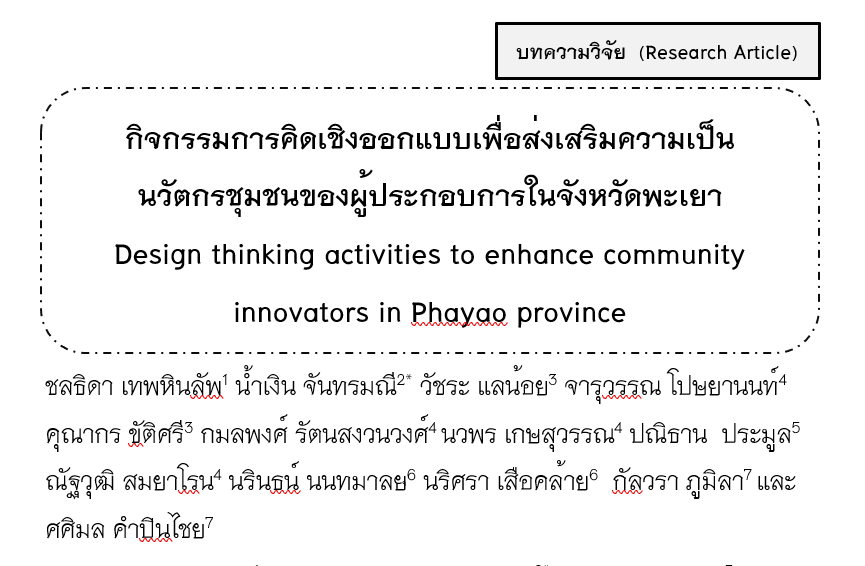Design Thinking Activities to Enhance Community Innovators in Phayao Province
Keywords:
Design Thinking, Learning and Innovation Skills, Community InnovatorAbstract
This research aimed to (1) develop design thinking activities to promote the idea of local innovator to entrepreneurs in Phayao (2) study result of design thinking activities and (3) survey satisfaction of entrepreneurs in Phayao towards design thinking activities. This was an action research project with two phases: the first involved developing design thinking activities to promote community innovators and entrepreneurs in Phayao Province, and the second phase involved studying the outcomes of using design thinking activities to promote community innovators and entrepreneurs in Phayao Province. The researcher administered research tools: design thinking test, learning skill and innovation assessment and satisfaction survey to 47 entrepreneurs in Phayao. The collected data were analyzed by descriptive statistics: average values and standard deviation and inferential statistics: dependent sample t-test and content analysis.
The research result revealed that
- Design thinking activities to promote the idea of local innovator to entrepreneurs in Phayao consist of 5 steps: (1) developing profound understanding (2) setting problem-solving direction (3) problem-solving design (4) creating innovation prototype (5) innovation testing
- After undertaking design thinking activities, learning skill and innovation of the entrepreneurs increased statistically at a significant level of 0.05.
- The level of satisfaction of the entrepreneurs towards design thinking activities was found at the highest level
References
กองแผนงาน มหาวิทยาลัยพะเยา. (2562). แผนยุทธศาสตร์การพัฒนามหาวิทยาลัยพะเยา ประจำปีงบประมาณ พ.ศ. 2562 – 2565. พะเยา: มหาวิทยาลัยพะเยา.
พระราชบัญญัติมหาวิทยาลัยพะเยา พ.ศ. 2553. (2553, 16 กรกฎาคม). ราชกิจจานุเบกษา. เล่ม 127 ตอนที่ 44 ก, 4–29.
พิชญา กล้าหาญ และ วิสูตร โพธิ์เงิน. (2564). การพัฒนากิจกรรมการเรียนรู้ตามแนวคิด กระบวนการคิดเชิงออกแบบร่วมกับการจัดการเรียนรู้โดยใช้โครงงานเป็นฐาน เพื่อ ส่งเสริมความเป็นนวัตกรของนักเรียนชั้นมัธยมศึกษาปีที่ 4. วารสารครุศาสตร์ จุฬาลงกรณ์มหาวิทยาลัย, 49(2), 1-16.
ภานนท์ คุ้มสุภา. (2562). นวัตกรท้องถิ่นรุ่นใหม่กับการแพร่กระจายนวัตกรรมสู่ชุมชน. วารสารนิเทศศาสตร์ธุรกิจบัณฑิตย์, 13(2), 258-299.
วาทินี บรรจง. (2561). นักออกแบบตัวน้อย: การส่งเสริมความคิดสร้างสรรค์ผ่านประสบการณ์ศิลปะสร้างสรรค์ด้วยกระบวนการคิดเชิงออกแบบ. วารสารครุศาสตร์ จุฬาลงกรณ์มหาวิทยาลัย, 46(2), 330-347.
สำนักงานนวัตกรรมแห่งชาติ. (2564). มาฝึกฝนทักษะ 5I เพื่อเป็นนวัตกรในศตวรรษที่ 21 [Online]. สืบค้นวันที่ 1 มีนาคม 2565, จาก https://www.nia.or.th/5I.
สำนักงานสถิติแห่งชาติ. (2565). สถิติรายได้และรายจ่ายของครัวเรือน. สืบค้น 1 มีนาคม 2565, จาก http://statbbi.nso.go.th/staticreport/page/sector/th/08.aspx.
สำนักงานสภาพัฒนาการเศรษฐกิจและสังคมแห่งชาติ. (2564). ผลิตภัณฑ์ภาคและจังหวัดแบบลูกโซ่ ฉบับ พ.ศ. 2562. กรุงเทพฯ: กองบัญชีประชาชาติ สำนักงานสภาพัฒนาการเศรษฐกิจและสังคมแห่งชาติ.
สุภรพรรณ คนเฉียบ และ มิ่งขวัญ กันจินะ. (2563). ผลการประเมินตนเองด้านทักษะการเรียนรู้และนวัตกรรมของนักศึกษาไทยที่เขาร่วมกิจกรรมการคิดเชิงออกแบบเพื่อนวัตกรรมทางสังคม. วารสารการพัฒนาชุมชนและคุณภาพชีวิต, 8(2), 327-338
Billings, C. E. (2018). Aviation automation: The search for a human-centered approach: CRC Press.
Blohm, I., & Leimeister, J. M. (2013). Gamification. Business & information systems engineering, 5(4), 275-278.
Carlgren, L., Rauth, I., & Elmquist, M. (2016). Framing design thinking: The concept in idea and enactment. Creativity and innovation management, 25(1), 38-57.
Cohen, L. J. (1977). The probable and the provable. Clarendon Press Oxford.
Plattner, H., Meinel, C., & Weinberg, U. (2009). Design-thinking. Springer.
Shumer, R. (1994). Community-based learning: Humanizing education. Journal of adolescence, 17(4), 357-367.
Tett, L. (2006). Community education, lifelong learning and social inclusion. Dunedin Academic Press.
Tim, B. & Jocelyn, W. (2010). Design Thinking for Social Innovation. Stanford Social Innovation Review Winter 2010.

Downloads
Published
How to Cite
Issue
Section
License
Copyright (c) 2022 Phayao University

This work is licensed under a Creative Commons Attribution-NonCommercial-NoDerivatives 4.0 International License.
ผู้นิพนธ์ต้องรับผิดชอบข้อความในบทนิพนธ์ของตน มหาวิทยาลัยพะเยาไม่จำเป็นต้องเห็นด้วยกับบทความที่ตีพิมพ์เสมอไป ผู้สนใจสามารถคัดลอก และนำไปใช้ได้ แต่จะต้องขออนุมัติเจ้าของ และได้รับการอนุมัติเป็นลายลักษณ์อักษรก่อน พร้อมกับมีการอ้างอิงและกล่าวคำขอบคุณให้ถูกต้องด้วย
The authors are themselves responsible for their contents. Signed articles may not always reflect the opinion of University of Phayao. The articles can be reproduced and reprinted, provided that permission is given by the authors and acknowledgement must be given.







